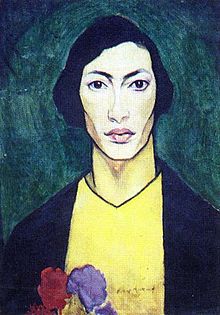Natan Issajewitsch Altman
Nathan Altman ( Russian Натан Исаевич Альтман . Scientific transliteration Natan Isaevič Al'tman * 10; jul. / 22. December 1889 greg. In Vinnytsia , † 12. December 1970 in Leningrad ) was a Jewish-Soviet painter and stage designer.
Life
Natan Altman was born in the family of a poor Jewish merchant in the Podolian regional capital Vinnytsia . He studied at a religious Jewish school ( cheder ) and then at a state primary school in Vinnytsia. From 1902 to 1907 he studied at the Art School in Odessa .
In 1910 and 1911 he stayed in Paris , where he continued his studies of painting and sculpture at the Russian school of Maria Wassiljewa . In Paris he met u. a. with Marc Chagall , Alexander Archipenko and Dawid Schterenberg . He also came into close contact with Jewish intellectuals such as Chaim Nachman Bialik .
After returning to Vinnytsia, where he gave drawing lessons, he went to Saint Petersburg in 1912 , where he lived until 1921. Altman was one of the founders of the Jewish Society for the Advancement of the Arts (Еврейское общество поощрения художеств) .
He strove to combine old Jewish symbolism with elements of Art Nouveau . Later his work approached the style of the international avant-garde, cubism , futurism and vorticism . His best known work is a portrait of the poet Anna Akhmatova (Портрет Анны Ахматовой) from 1914.
After the October Revolution he held various offices in cultural and cultural-political institutions. In 1920 he made a bronze portrait of VI Lenin . From 1921 to 1928 he lived in Moscow . From 1922 he also worked as a set designer for the State Jewish Theater .
The First Russian Art Exhibition in Berlin in 1922 showed the following selection: the paintings Russia (polychromic object) , petro-communa , painting , the sculpture Head of a Young Jew and several watercolors , drawings and studies. With him began a new ramification of non-representational art. He approximated the visible composition of the image to the material construction of things and thereby gave it a conscious, social content. His works not only wanted to influence the eye, but also to organize consciousness. The basis of his work was the material itself, which he knew how to enrich.
In 1924 he designed the sets in the film Jüdisches Glück . In 1925 he received the gold medal at the Exposition Internationale des Arts Décoratifs et industriels modern in Paris. In 1928 he went to Paris again.
After his return in 1936 he lived in Leningrad until his death in 1970.
literature
- Iozef Kiblickij (ed.): Futurism in Russia and David Burliuk, “Father of Russian Futurism”: Catalog for the exhibition “Russian Futurism”, September 17 to November 26, 2000, Von-der-Heydt-Museum Wuppertal / State Russian Museum . Palace Editions, [Wetzlar] 2000, ISBN 3-930775-91-3 .
- Thomas Christ: Socialist Realism - Considerations on Socialist Realism in the Soviet era . Wiese Verlag, Basel 1999, ISBN 3-909164-68-4 .
- Eberhard Roters (Ed.): First Russian Art Exhibition: Berlin 1922. (Commented by Horst Richter): Galerie van Diemen & Co., Berlin 1922 . König (reprint), Cologne 1988, ISBN 3-88375-085-9 .
Web links
- Biography on www.007-berlin.de
- Article in the Encyclopedia Krugosvjet (Russian)
- Biography with paintings ( Memento from May 25, 2007 in the Internet Archive ) (Russian)
Individual evidence
- ↑ Encyclopaedia Judaica , Volume II (Alr-Az), Thomson Gale, 2nd ed., 2007, ISBN 9780028659305 , pp. 21 and 22
- ↑ Encyclopaedia Judaica , Volume II (Alr-Az), Thomson Gale, 2nd ed., 2007, ISBN 9780028659305 , pp. 21 and 22
| personal data | |
|---|---|
| SURNAME | Altman, Natan Issajewitsch |
| ALTERNATIVE NAMES | Altmann, Nathan; Altman Nathan; Altmann Natan; Альтман, Натан Исаевич (Russian spelling) |
| BRIEF DESCRIPTION | Russian-Soviet painter and stage designer |
| DATE OF BIRTH | December 22, 1889 |
| PLACE OF BIRTH | Vinnytsia |
| DATE OF DEATH | December 12, 1970 |
| Place of death | Leningrad |
